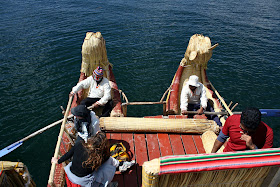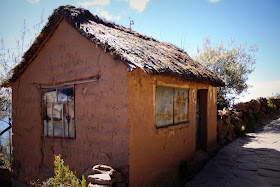After a long journey from the Peruvian Amazon, Cusco, The Sacred Valley, and the Lost City of the Incans (aka Machu Picchu), we loaded up on a bus to drive approximately 14 hours from Cusco to southern Peru, to a city called Puno which sits right on
Lake Titicaca, the highest navigable lake in the world! At a staggering 118 miles long by 50 miles wide and sitting at almost 13,000 feet elevation, it's no wonder it's a record breaker!
The bus ride from Cusco took us through lots of country side, farms, and small towns. It was so great to catch a glimpse into the lives of Peruvians and compare with what we had seen in different areas of Peru.
We eventually stopped at Raqchi. The reason this place is so interesting? It's one of the very first Incan structures standing today. It dates back further than the structures at Machu Picchu and throughout the Sacred Valley. The Incans utilized the same stone work at the bottom of the walls, but then used a mud and clay mixture for the rest. You can see the difference in the picture below. What's so incredible about this is that the clay mixture is still around after all these centuries - and that is because the Incans used the nectar from a local cactus plant to help bind it together, and it has ultimately prevented these walls from completely deteriorating.
After leaving Raqchi, we continued on the highway at VERY high elevations. Altitude sickness definitely began to kick in for some. Fortunately enough, I wasn't really affected. It must have been all the Coca tea I talked about in
Peru: Part 2 of 3. :)
Here are some images along the high desert highway.
After many many hours on a bus, we approached
Juliaca. In my opinion, formed through a brief drive through the city, it was a very sad a desolate place. Nearly every building in the city remained unfinished with rebar shooting out the tops to the sky. Our guide told us this is very common as locals will save up until they can afford to complete another floor of their home. For many, this occasion comes once every 20-30 years! The streets were mostly dirt and the side streets looked as if a bomb had destructed. With the very haunting visual of a dog lying dead in the street, I was pretty much ready to get out of here and get to Puno on Lake Titicaca!
As we rounded a hill, Lake Titicaca came into view.
We settled into our hotel in Puno and ventured out for a quick dinner.
The next morning, we loaded up in a very VERY stinky, exhaust filled boat. I quickly discovered that the roof top deck was the place to be if you enjoyed breathing air.
As we approached the Floating Islands of Lake Titicaca, also known as the Uros Islands, it became clear why there was so much interest around this place. The grouping of around 40 floating islands are all made from surrounding reeds. The Uros people collect these and build layer upon layer of cut reeds on top of the reed roots which float on the water. It's incredible!
We received a warm, song-filled welcome as we approached. As you step onto the island, you can feel the buoyancy of it on the water. It's almost like walking on a firm waterbed.
Here's a shot of one of the houses made from reeds - all water tight, of course. This family was lucky enough to receive a solar panel from a group who came to visit. This is enough to power a very small bunny-eared television they have propped up inside.
They then gave us a detailed tutorial about how the islands are built and maintained. If someone was to be married, the two families could merge their floating islands together. And of course, they joked that if it didn't work out the two families can just saw the island in half and float away from each other!
One family was kind enough to let us inside their home. You can see in this single-room home, there is one bed in which the entire family sleeps on together. Their clothing is hung up on the wall to the left. Talk about being a close-knit family! :)
Our stinky boat...
The "Mercedes Benz" of boats... of course, as it is the theme here, completely made of reeds.
Once bidding farewell to our Uros friends, we continued on to
Amantani Island where we were to stay for two nights with a local family. Upon arrival, Sylvia guided us from the water, up the hill to their home, where her and her mother had prepared some pretty incredible quinoa soup and Mente Tea.
After a delicious lunch, we settled into our new temporary home to relax for a bit.
Later that evening, we met up with some of our tour group friends to hike one of the two hills on Amantani Island, Pachamama (meaning Mother Earth). The other hill is name Pachatata (meaning Father Earth). At the tops of each are a temple which the Amantani people include in an annual celebration/festival.
These mountains sit in Bolivia. Bolivia shares part of Lake Titicaca with Peru and there is an ongoing debate as to which country owns the majority of the lake... touchy subject here. :)
We hiked back down from Pachamama to find that our host family had an incredible dinner ready for us, cooked in the very small one-room kitchen. The stove/over is a hole cut into the side of one of the walls with a hand-built fire burning. Let me just say, I think it's incredible what this woman can do with such little! Lessons, please!
After dinner, the other girls were feeling a little tired and sick from the altitude sickness, so I ventured out on my own with Sylvia, a girl in our host family. Of course, none can speak any English, so my broken Spanish did seem to help some! Although, Spanish is their second language to their local regional language.
Sylvia dressed me up in her traditional Peruvian clothing and took me out on the town! Well, ok... up the path to a larger single-room where the local fiesta was taking place. There was a live band playing traditional music and I got a crash course in the local dance techniques!
The next morning before our departure, the lovely ladies made us some pancakes with jam and some Mente tea. This is a plant that grows wild in the area and is also very good for altitude sickness (just like Coca!)
After departing Amantani Island, we made a stop at
Taquile Island on our way back to Puno. While there, we hiked around on the paths up to the main square. Along the way, we met some very lovely children on their way to school, a woman preparing her yarn for her beautiful creations, and saw more of the beautiful and very relaxed Peruvian lifestyle.
We stopped for lunch overlooking Lake Titicaca, and enjoyed some fish, rice, and soup, before hopping back on our boat for Puno.
On our last night in this region, we met up with some of our new friends in a very lovely restaurant in Puno. You gotta love meeting new people from all over the world (and sometimes from your hometown!).
Here are my tired feet and poor socks just prior to meeting the bizbag. Bye bye socks!
On our way to the Juliaca airport to fly back to
Lima for a night before returning home to the United States!
Once in Lima, we experienced a completely drastic type of Peruvian lifestyle...
And finally, one last long flight back to the Pacific Northwest! Nothing like the Cascade Mountain range to offer a nice, warm welcome home!
Thank you Peru and all the wonderful Peruvian people we met for a trip of a lifetime and memories I will never forget!!!



























































































